Comprehensive condensation flow regimes in air gap membrane distillation: Visualization and energy efficiency
Author(s)
Warsinger, David Elan Martin; Swaminathan, Jaichander; Morales, Lucien L.; Lienhard, John H.
DownloadWARSINGER-AGMD-condensation-regimes-JMS-2018-preprint.pdf (2.658Mb)
OPEN_ACCESS_POLICY
Open Access Policy
Creative Commons Attribution-Noncommercial-Share Alike
Terms of use
Metadata
Show full item recordAbstract
The thermal performance of air gap membrane distillation (AGMD) desalination is dominated by heat and mass transfer across the air gap between the membrane and the condensing surface. However, little is known about the impact of condensate flow patterns in some design variations of the air gap. In this study, air gap membrane distillation experiments were performed at various inlet temperatures, varying module inclination angle, condensing surface hydrophobicity, and gap spacer design to identify the effect of each on the permeate production rate and thermal efficiency of the system. Additionally, this study is one of the first with enhanced visualization of flow patterns within the air gap itself, by using a transparent, high thermal conductivity sapphire plate as the condenser surface. System-level numerical modeling is used to further understand the impact of these flow regimes on overall energy efficiency, including flux and GOR. A brief review of membrane distillation condensation regimes is provided as well. For tilting the AGMD flat-plate module, permeate flux was barely influenced except at extreme positive angles ( > 80°), and moderate negative angles ( < −30°), where condensate fell onto the membrane surface. The surface with the hydrophobic coating (for dropwise condensation) was shown to have better droplet shedding (with very small nearly spherical droplets) and fewer droplets bridging the gap. Superhydrophobic surfaces (for jumping droplet condensation) were similar, with much smaller droplet sizes. Such surfaces could improve AGMD efficiency while avoiding flooding, as better performance (2x higher GOR) is reached with much smaller gap sizes ( < 0.2 mm) than currently attainable gaps with filmwise condensation ( > 1 mm). Meanwhile, the hydrophilic surface for small gap sizes ( < 3 mm) often had pinned regions of water around the hydrophilic surface and plastic spacer. Overall, the various results imply that the common assumption of a laminar condensate film poorly describes the flow patterns in real systems for all tilt angles and most spacer designs. Real system performance is likely to be between that of pure AGMD and permeate gap membrane distillation (PGMD) variants, and modeling shows that enhanced condensing in air gaps may improve system energy efficiency significantly, with strong relative advantages at high salinity. Keywords: Membrane distillation; Hydrophobic surface; Air gap; Condensation; Visualization
Date issued
2018-03Department
Massachusetts Institute of Technology. Department of Mechanical EngineeringJournal
Journal of Membrane Science
Publisher
Elsevier
Citation
Warsinger, David M. et al. “Comprehensive Condensation Flow Regimes in Air Gap Membrane Distillation: Visualization and Energy Efficiency.” Journal of Membrane Science 555 (June 2018): 517–528 © 2018 Elsevier B.V.
Version: Author's final manuscript
ISSN
0376-7388